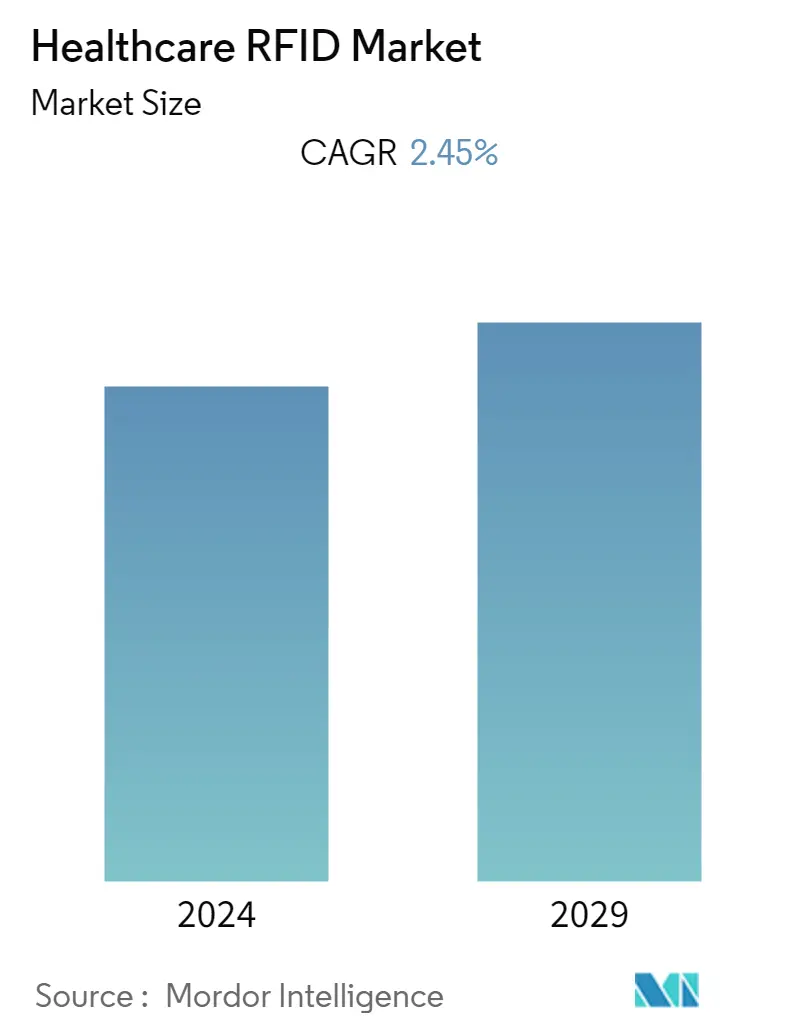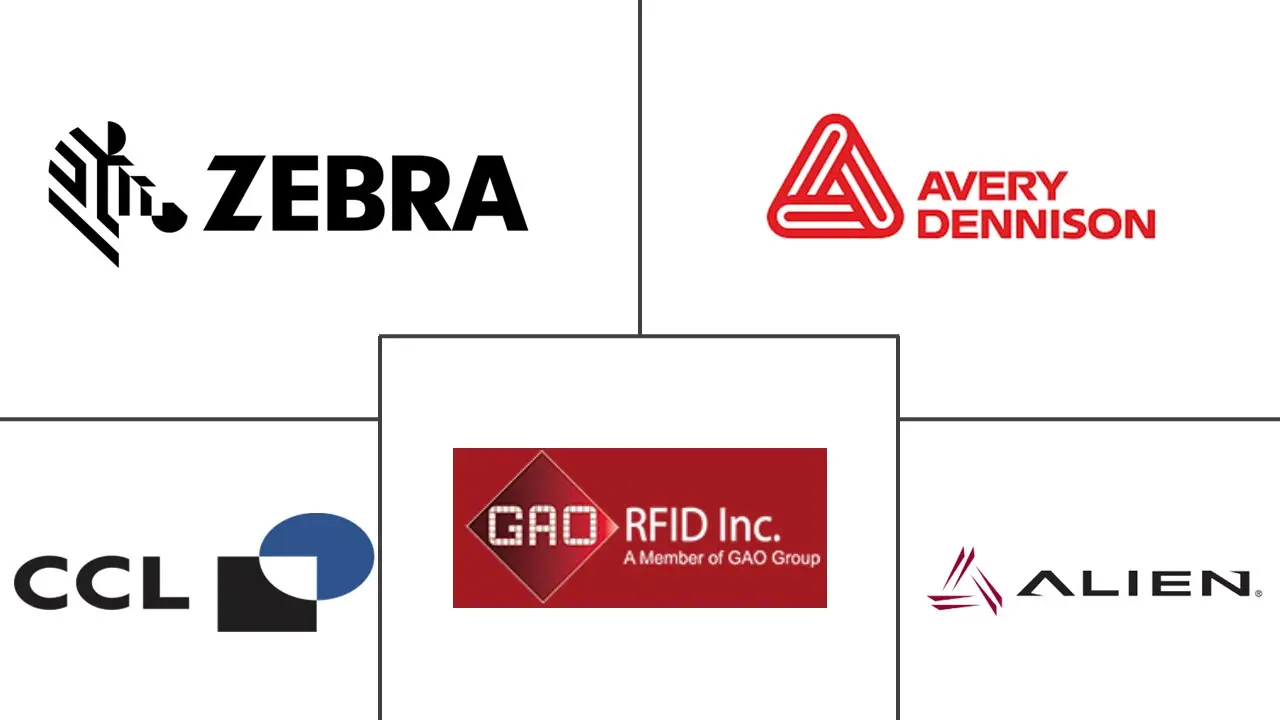Market Size of Healthcare RFID Industry

| Study Period | 2019 - 2029 |
| Base Year For Estimation | 2023 |
| CAGR | 2.45 % |
| Fastest Growing Market | Asia Pacific |
| Largest Market | Asia Pacific |
| Market Concentration | Low |
Major Players
*Disclaimer: Major Players sorted in no particular order |
RFID in Healthcare Market Analysis
The RFID Market in Healthcare was estimated at USD 1,231.07 million in the current year. The market is expected to reach USD 1,389.45 million in five years, registering a CAGR of 2.45% during the forecast period.
RFID technology has significantly impacted hospitals, clinics, healthcare systems, distributors, and manufacturers worldwide but is due to achieve even more in years to come. The adoption of RFID in the medical field has become a catalyst for more and more pharmaceutical companies to put RFID tags on medicine labels to control their supply chain. The adoption of RFID will thus continue to have a more vital role in the healthcare sector.
- Multinational pharmaceutical companies have been manufacturing medicines for decades to distribute worldwide. Labelling, however, is a rigorous and challenging task that continues to grow more complex. With new labeling regulations that can vary widely across the country and region, which are predicted To stimulate growth in the RFID market by a large margin, pharmaceutical companies must either build their systems to meet global needs or delegate them to experts to be able to do so.
- Integrating RFID in pharmaceutical products will help increase patient safety because it allows for more precise control and authentication of medicinal products throughout the supply chain, aiming to reduce errors to almost zero. In addition, it eliminates the need for costly and, more importantly, labor-intensive in-house medication labeling, thereby relieving a significant burden on hospital staff.
- RFID may be applied for inventory management at hospitals and pharmacies to ensure quality and reduce waste. The benefits go beyond the return on investment since it has the potential to save lives. That is why, to provide pharmacies, hospitals, and patients with critical information, industry players are putting together a premium product portfolio that includes tamper-evident RFID tags and luminous labels; these smart RFID solutions will help to reduce costs, raise accuracy, and speed up operations while protecting pharmaceutical brands from counterfeiting.
- A few factors slowing down the market studied include high installation costs for RFID systems in healthcare and system interoperability. Any industry adopting RFID must invest significantly in readers, tags, software, electricity, and operating replacement services. Additional features such as integration of Internet of Things components, system reliability testing, and training costs add to the cost of an RFID solution.
- Hospitals use RFID technology to manage patients and staff better during pandemics due to the COVID-19 outbreak. The healthcare industry has seen a great uptake of RFID devices, which use radio waves to identify and track assets and equipment. RFID will increase the efficiency and accountability of healthcare teams as we continue to face a Public Health Emergency.
RFID in Healthcare Industry Segmentation
The study considers revenues accrued from the sales of RFID products offered by various vendors operating in the healthcare market.
The scope of the study includes RFID products, such as RFID systems, tags, and labels, used in various end-user industries, such as hospitals, pharmaceuticals, research institutes, laboratories, and other end-user industries in multiple regions worldwide. The inputs from the primary interviews were also considered for the market estimation and projection. Based on current patterns, the report presents an in-depth analysis of COVID-19's influence on the RFID market in the Healthcare Sector. It describes the significant growth prospects expected to emerge for existing and new market players.
The RFID market in healthcare can be segmented by product (tags & labels and RFID systems (asset tracking systems, patient tracking systems, pharmaceutical tracking systems, and blood monitoring systems), end-user (hospitals and pharmaceuticals), and geography (North America (United States, Canada, Mexico), Europe (Germany, United Kingdom, France, Italy, Spain, rest of Europe), Asia Pacific (China, Japan, India, Australia, South Korea, rest of Asia Pacific), South America, Middle East & Africa).
The market sizes and forecasts are provided in terms of value (USD) for all the above segments.
| By Product | ||||||
| Tags and Labels | ||||||
|
| By End User | |
| Hospitals | |
| Pharmaceuticals | |
| Other End Users (Research Institutes and Laboratories) |
| By Geography | ||||||||
| ||||||||
| ||||||||
| ||||||||
| South America | ||||||||
| Middle East & Africa |
Healthcare RFID Market Size Summary
The RFID healthcare market is experiencing a transformative phase, driven by the increasing adoption of RFID technology across hospitals, clinics, and pharmaceutical companies worldwide. This technology is becoming integral in enhancing supply chain management, improving patient safety, and streamlining operations within the healthcare sector. The implementation of RFID tags on medication labels is particularly noteworthy, as it aids in controlling the distribution of pharmaceuticals, thereby reducing errors and counterfeiting. The market is characterized by a competitive landscape with numerous regional and international players, leveraging advancements in technologies like the Internet of Things and cloud computing to gain a competitive edge. Despite the high initial costs and challenges related to system interoperability, the benefits of RFID in terms of cost reduction, accuracy, and operational efficiency are driving its adoption.
The healthcare RFID market is further propelled by stringent regulatory requirements in the pharmaceutical sector, which mandate improved tracking and authentication of medicinal products. This regulatory environment is encouraging pharmaceutical companies to integrate RFID solutions to enhance quality control and reduce the risk of counterfeit drugs. Additionally, the use of RFID for inventory management in hospitals and pharmacies is gaining traction, as it helps in minimizing waste and ensuring the availability of essential medical supplies. The market's growth is supported by the rising demand for efficient healthcare services, driven by increasing medical costs and the need for improved patient care. Key players in the market are continuously innovating and expanding their product portfolios to meet the evolving needs of the healthcare industry, as evidenced by recent collaborations and technological advancements.
Healthcare RFID Market Size - Table of Contents
-
1. MARKET INSIGHTS
-
1.1 Market Overview
-
1.2 Industry Value Chain Analysis
-
1.3 Industry Attractiveness - Porter's Five Forces Analysis
-
1.3.1 Bargaining Power of Suppliers
-
1.3.2 Bargaining Power of Buyers/Consumers
-
1.3.3 Threat of New Entrants
-
1.3.4 Threat of Substitute Products
-
1.3.5 Intensity of Competitive Rivalry
-
-
1.4 Assessment of the Impact of COVID-19 on the Industry
-
-
2. MARKET SEGMENTATION
-
2.1 By Product
-
2.1.1 Tags and Labels
-
2.1.2 RFID Systems
-
2.1.2.1 Asset Tracking Systems
-
2.1.2.2 Patient Tracking Systems
-
2.1.2.3 Pharmaceutical Tracking Systems
-
2.1.2.4 Blood Monitoring Systems
-
-
-
2.2 By End User
-
2.2.1 Hospitals
-
2.2.2 Pharmaceuticals
-
2.2.3 Other End Users (Research Institutes and Laboratories)
-
-
2.3 By Geography
-
2.3.1 North America
-
2.3.1.1 United States
-
2.3.1.2 Canada
-
2.3.1.3 Mexico
-
-
2.3.2 Europe
-
2.3.2.1 Germany
-
2.3.2.2 United Kingdom
-
2.3.2.3 France
-
2.3.2.4 Italy
-
2.3.2.5 Spain
-
2.3.2.6 Rest of Europe
-
-
2.3.3 Asia Pacific
-
2.3.3.1 China
-
2.3.3.2 Japan
-
2.3.3.3 India
-
2.3.3.4 Australia
-
2.3.3.5 South Korea
-
2.3.3.6 Rest of Asia Pacific
-
-
2.3.4 South America
-
2.3.5 Middle East & Africa
-
-
Healthcare RFID Market Size FAQs
What is the current RFID Healthcare Market size?
The RFID Healthcare Market is projected to register a CAGR of 2.45% during the forecast period (2024-2029)
Who are the key players in RFID Healthcare Market?
Zebra Technologies Corporation, Avery Dennison Corporation, CCL Industries Inc., Alien Technology Corporation and GAO RFID, Inc are the major companies operating in the RFID Healthcare Market.

